Exploring Wild Jamaica

The Blue Mountains
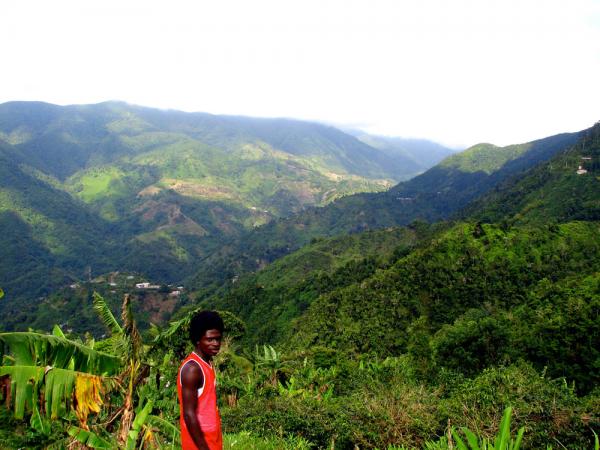
When most people imagine Jamaica they think of tropical white-sand beaches, swaying palm fronds and the laid-back island culture of the Caribbean. Jamaica lives up to these wonderful clichés, but can also confound them. Traveling deep into the interior of the little-visited eastern part of the island, beaches give way to undulating hills dotted with small villages and coffee farms that patchwork the land like a quilt. As their name suggests, a faint blue haze seems to hang suspended over these rolling ridge tops.
From the air, the Blue Mountains appear to rise up dramatically from the sea. Traveling north over the capital, Kingston, the sprawl of the city trickles away to small villages as you go deeper into the Blue Mountains. Eventually even the outline of villages disappears and all that remains is a lush carpet of hillsides. Underneath this green blanket ancient tree ferns rise from mossy banks, colorful tropical birds dart through sunbeams in the forest, and crystal clear steams trickle down to the sea. Away from the hot, humid air of the lowlands, the air up here is cool and inviting.
In the villages

Idyllic as it all appears from the air, on the ground it is often no easy task traveling into the Blue Mountains. Roads ascending the hills zigzag in elaborate, and often, nausea-inducing directions. To warn of their approach, drivers lay on their horns coming down steep switchback curves barely big enough for two vehicles, while in some places heavy rain and landslides may have obliterated the roads altogether.
Despite the difficulty of traveling into the Blue Mountains, many small communities of people exist here. Hardy and self-sufficient, most villagers rely upon farming the steep hillsides to survive. Home to dozens of communities, children like these are a common sight along the roadsides, staring curiously from doorways or walking the foot trails home from school every afternoon.
The coffee lands
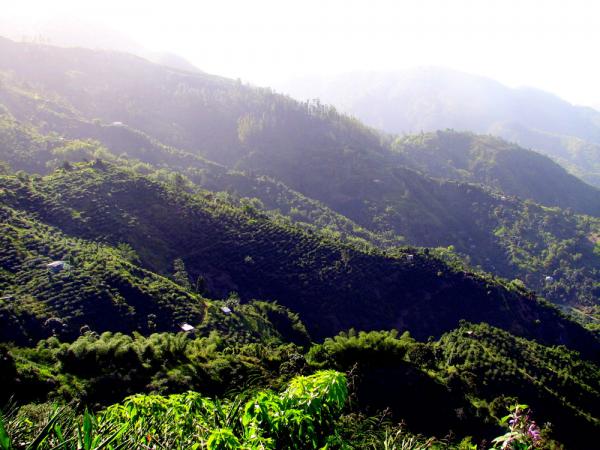
Hillsides lined with coffee bushes such as this one are a defining feature in the Blue Mountains, where many farmers may grow little else. Coffee was first introduced to the Blue Mountains during British rule as far back as 1728. More coffee farmers arrived after fleeing the Haitian Revolution in 1792, further boosting the industry.
Today, Jamaican Blue Mountain coffee has become widely recognized and justifiably famous, fetching top dollar prices in the world coffee market. With over 80 percent of the crop sold every year to Japan, where it is considered a delicacy, a cup of Blue Mountain joe is a rare and special treat for many a coffee aficionado.
The Blue Mountains' coffee is so prized because of the unique microclimates produced in these mountains. The cooler, misty climate, coupled with acid soils and abundant tropical sun, gives Blue Mountain coffee a subtle, but distinct taste prized by connoisseurs.
The Blue & John Crow Mountains National Park

Beyond the mountain villages and coffee plantations, thick tropical broadleaf forests march up the slopes to as high as 7,403 feet (2,256 meters) at Blue Mountain Peak, the highest point on the island. These forests serve as the living heart of Jamaica, filtering the air through their respiration and safeguarding the innumerable waterways that feed the island's crops and drinking water reserves. These forests also hold the steep mountain soils in place and serve as a refuge to a fantastic array of plants and animals.
Recognizing the value of the forests as a great reservoir of life, water and livelihoods for the entire island, the Blue Mountains and adjoining John Crow Mountains were designated as the country's first national park in 1993. The park covers some 196,000 acres (79,321 hectares) of closed canopy broadleaf forest and is the major watershed for Kingston and all of Eastern Jamaica. With over 500 flowering plants 40 percent of which are found nowhere else and at least 200 species of birds, the park contains some of the highest numbers and rarest types of species in the whole Caribbean.
Rasta bird

The Jamaican Tody (Todus todus) is just one of many unique creatures found within the Blue Mountains. A distant relative of kingfishers, locals call this bird the Rastabird for its colorful Rastafarian-esque plumage. These cute, colorful and curmudgeonly little fellows are relatively common in these forests, but can be found nowhere else outside of Jamaica. Sitting nonchalantly on twigs and branches, they are most often noticed as small darting blips of color snatching insects under the canopy. Though small, they come with a voracious appetite, capable of eating well over their weight in insects in a single day!
The Blue and John Crow Mountains National Park is a refuge for the Tody and innumerable other plants and animals. Surviving in metaphorical "islands" of forest in the middle of the small island of Jamaica, creatures like the Tody occupy an increasingly fragmented and isolated natural world hemmed in by people.
Invasive species
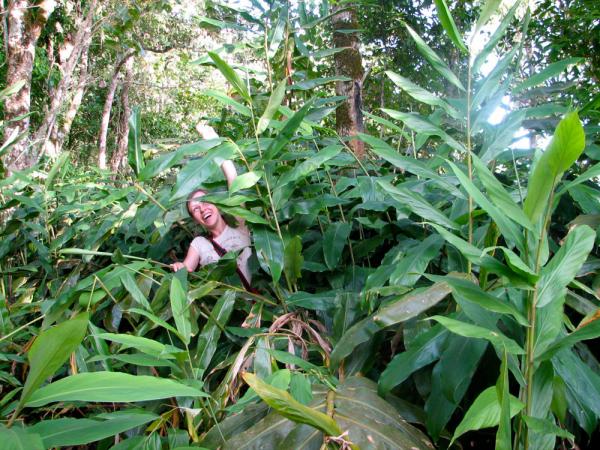
With people have come many other organisms that otherwise couldn't have gotten here without human help. Some of these accidental newcomers have learned to thrive in their new homes, invading at the expense of local species. Island ecosystems such as Jamaica's are especially fragile to invaders since the species that have evolved on them have no prior evolutionary experience with mainland predators and newly arrived competitors.
Some invasive plants like this Ginger Lily (Hydicium spicatum), originally native to South Asia, have become so prolific in the Blue Mountains they can literally smother you! With such steep competition for sunlight, nutrients and water, it is no wonder many native species have a hard time surviving. Other problematic invasives like mongoose and feral cats are such adept predators that they can easily silence forests of native birds.
The story is always the same once an invasive species becomes established it is difficult or near impossible to get rid of. With active eradication and restoration programs the spread of invasives can be kept at bay, though increasingly in the world today we are having to learn how to live with invasives while balancing the protection of native species.
The Rio Grande valley
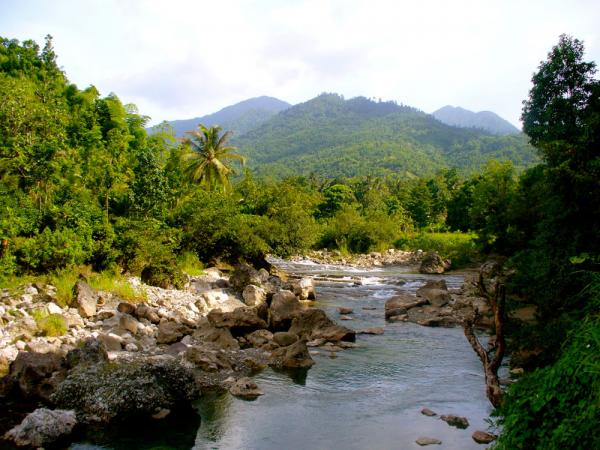
To the northeast of the Blue Mountains, the John Crow Mountains crease the island's flanks. Black vultures, also called John Crow birds in Jamaica, are a common site, cruising the high thermal updrafts over these ranges which are named after them. This region is also known for the mighty Rio Grande River, a major river of Jamaica.
As the John Crow Mountains are in the direct path of the easterly winds that flow over the island, abundant precipitation feeds the Rio Grande River's path to the sea. Warm, moisture-saturated air from the Caribbean is pushed up the slopes by easterly winds. Confronted there by cooler air able to hold less water, clouds dump their excess moisture as rain over the mountain slopes. Sometimes over 39 inches (1 m) of rain a year falls here, making this region one of the wettest places on Earth
>Small fish and shrimp, many found nowhere else, thrive in these upland valley streams shaded by tall native trees like Water Mahoe (Talipariti elatum). With luck you may even catch a glimpse of the rare Giant Swallowtail Butterfly (Papilio homerus). At 6 in (15 centimeters) in length it is one of the largest butterflies in the world. Endangered by logging of its habitat and hunted by collectors, the Blue and John Crow Mountains National Park is a last refuge for this butterfly and many other species.
Get the world’s most fascinating discoveries delivered straight to your inbox.
Roots, shoots, and fruits
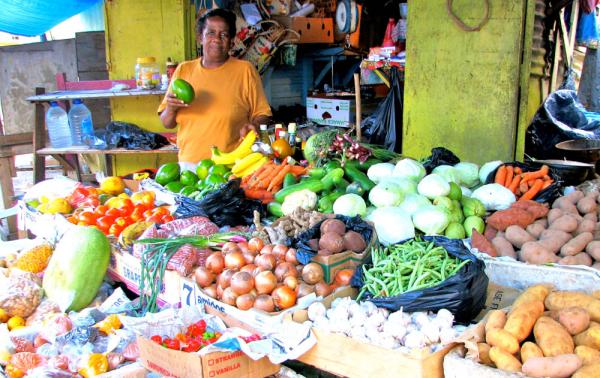
Clearing land for farming is the greatest threat to biodiversity in and around the Blue and John Crow Mountains National Park. Ways to make farming more environmentally friendly can go a long way towards conserving biodiversity while providing a healthy and sustainable food supply for the population. This type of agroecological farming is only just beginning to be applied in the Blue and John Crow Mountains where a wide variety of roots, shoots, fruits and vegetables are grown from the rich island soils.
Markets in Jamaica are a wholly interactive and sensory experiences. Bright colors, pungent smells, a constant chorus of market sounds and, of course, delicious tastes are all part of the experience. Looking around, the kaleidoscopic variety of fresh, locally grown and wild ingredients in these markets create a Jamaican cuisine unique to the Caribbean.
In addition to the usual fruits and vegetables, a visitor is likely to come across exotic crops like dasheen and yuca, both root vegetables consumed throughout Jamaica. Mangos, pineapple and papaya also prevail, as well as fruits less familiar, such as breadfruit, which tastes as it sounds, and a strange yellow fruit called ackee that looks and tastes like scrambled eggs when cooked. Top it off with fresh herbs and spices like escallion, nutmeg and scotch bonnet peppers for a mouthwatering experience.
Port Antonio
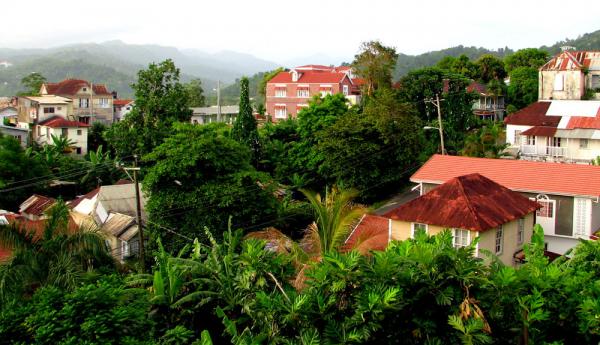
Several communities along the Rio Grande valley trace their descent from escaped slaves who fled deep into the mountains. These people are called the Maroons and fill a unique place in Jamaican history and culture.
Rebelling against British soldiers and sailors, the Maroons established their own independent and autonomous communities in the wilds of the Blue and John Crow Mountains. Maroon culture and identity still remain strong in this part of Jamaica today. The community of Moore Town in the nearby Rio Grande valley serves as the center of Maroon culture and is an easy excursion from the nearby city of Port Antonio, the parish capital of Eastern Jamaica.
To get their crops to market in the past, farmers in the John Crow Mountains would pole their wares on bamboo rafts down the Rio Grande River to Port Antonio. In its heyday in the 1930's Port Antonio was a bustling banana exporting port of call. Since the decline of the banana industry in Jamaica over the past several decades, Port Antonio feels more like a sleepy coastal town these days. With its laid-back atmosphere, delicious food and old colonial buildings, Port Antonio is a great base to explore the nearby mountains and white sand beaches.
Wild Jamaica
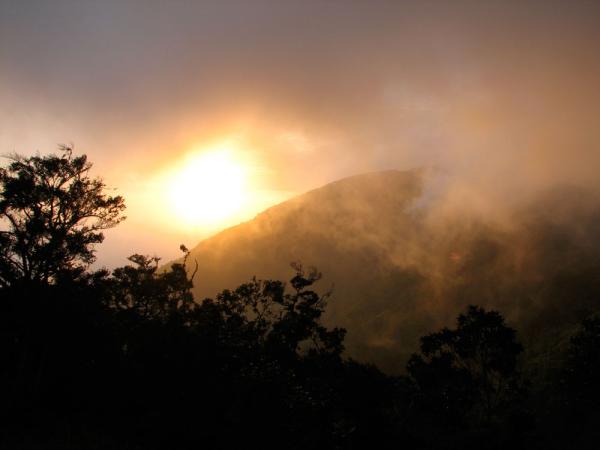
In the Blue and John Crow Mountains you can sit up on a high hillside and watch the sun glitter over the waters of the Caribbean Sea far below while mountain mists roll in like a cloudy memory to obscure the view. As the sun sets in the misty darkness, tree frogs croak as Jamaican fireflies, called peeneewallies, drift through the night like blinking Christmas lights. So close to the warm Caribbean and yet so far away, you bundle up your jacket in the cool air and snuggle into a warm sleeping bag to fall asleep to the chorus of frogs.
This is the Wild Jamaica I remember best and hold onto. To experience the Blue and John Crow Mountains for yourself, or to learn more about how to help conserve these forests, contact the Jamaica Conservation and Development Trust (JCDT) at www.jcdt.org. As an organization devoted to finding ways to protect and conserve the Blue and John Crow Mountains National Park, the JCDT trains local park guards, provides microfinance for environmentally inspired enterprise and oversees various research, monitoring and conservation outreach opportunities. They are always looking for volunteers to make a difference.


